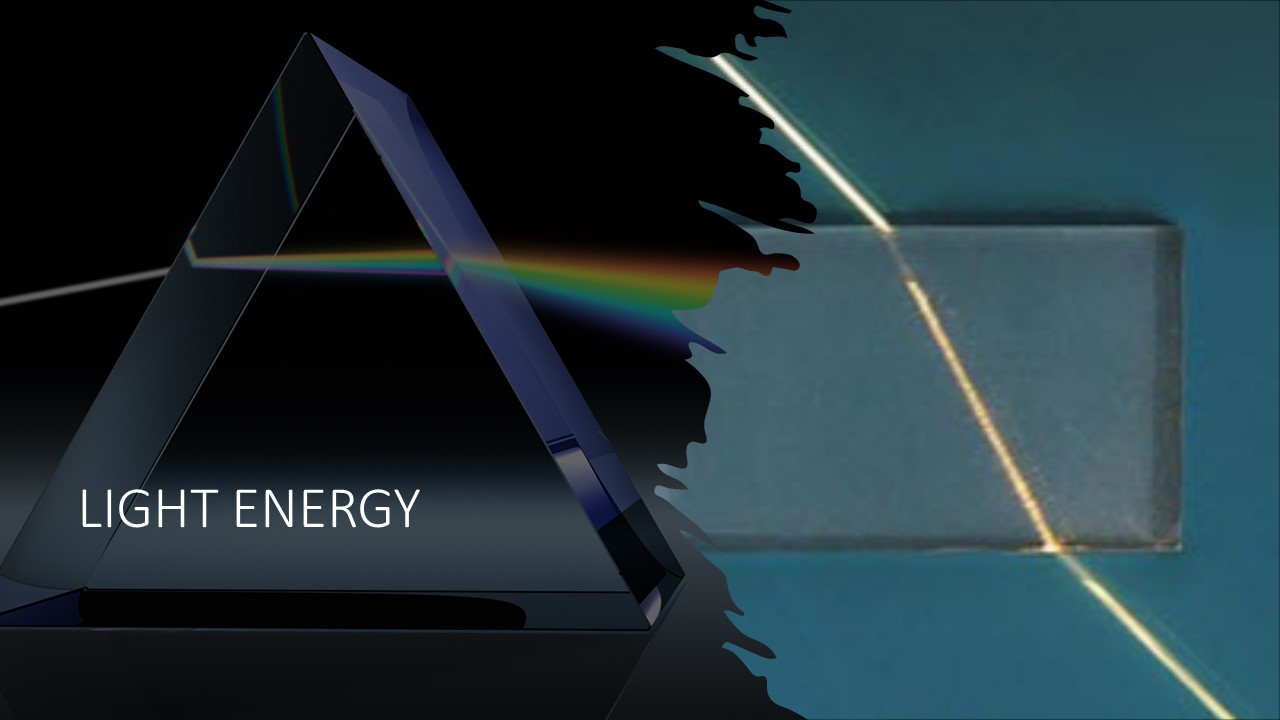STD VIII – LIGHT ENERGY (Hybrid)
About Course
In this section will learn the following chapters:
1.Refraction of Light
2.Ray Diagrams
3.Spectrum
Last Updated:January 7, 2025
0 (0 Ratings)
Share Course
Page Link
Share on social media

Description
Refraction of Light
When light passes through a transparent material like glass, it often bends and comes out in a slightly different place. This is called refraction.
For example, your spectacles that help with reading or seeing far-off objects work on this principle.
Refraction is also commonly seen in prisms. You can see light splitting and emerge out in its basic colours, Violet, Indigo, Blue, Green, Yellow, Orange and Red (VIBGYOR).
The most common occurrence of refraction in nature you must have seen is the appearance of a rainbow after during or after rain; especially when sunlight is also visible during the rain. Sunlight passes through tiny water droplets in the atmosphere. The tiny water droplets appear as one giant prism and when light passes through them, a rainbow is formed.
Curved Mirror
A curved mirror is a mirror with a curved reflecting surface. The surface may be either convex or concave. Most curved mirrors have surfaces that are shaped like part of a sphere, but other shapes are sometimes used in optical devices.
Ray Diagrams
What are Lenses
A transparent material bound by two surfaces, of which one or both surfaces are spherical, forms a lens. The two types of lenses are:
Convex lens or converging lens converges light rays.
Concave lens or diverging lens diverges light rays.
Important Terms
Centre of Curvature | Principal Axis | Optical Centre | Aperture | Focal Length
Spectrum
A spectrum is a condition that is not limited to a specific set of values but can vary, without steps, across a continuum. The word was first used scientifically in optics to describe the rainbow of colors in visible light after passing through a prism.
Free
Free
Free access this course
-
LevelIntermediate
-
Total Enrolled4
-
Last UpdatedJanuary 7, 2025
Hi, Welcome back!
Material Includes
- 🔥 Live Interactive classes with in-class doubt solving
- ⭐ Weekly Test and Quiz with instant tracking for progress
- ⚙️ Revision of the course after testing
- 👋 Fortnightly Parents and Tutor interactions
- 🌷 Expert monitoring of student's learning progress
- 👨👩👧👧 Daily communication over call, whatsapp and mail
- 💻3 hours on-demand video
- ✍4 downloadable resources
- ⌛Access for entire Academic Year
- 📱Access on mobile and Desktop
- 📋Assignments and review of the same
- 💡Tests and Correction by Board paper checkers
- 🏅Certificate of completion and Live tracking with Grade book
Course Duration:
0
Course level:Intermediate
Enrolled:4
About Course
In this section will learn the following chapters:
1.Refraction of Light
2.Ray Diagrams
3.Spectrum
Course Curriculum
REFRACTION OF LIGHT THROUGH PLANE SURFACES – 10 JAN 2023 – REFRACTION THROUGH PLANE SURFACES
-
LIGHT – CORE CONCEPT – SOURCES OF LIGHT
12:46 -
REFRACTION – CORE CONCEPT A – INTRODUCTION
03:10 -
LIGHT – CORE CONCEPT – LUMINOUS AND NON LUMINOUS
21:23 -
REFRACTION – CORE CONCEPT – REFRACTION OF LIGHT
03:10 -
LIGHT – CORE CONCEPT – TECHNICAL TERM RELATED TO LIGHT
20:09 -
REFRACTION – CORE CONCEPT – LIGHT TRAVELING FROM ONE MEDIUM TO ANOTHER
08:38 -
REFRACTION – CORE CONCEPT – LAWS OF REFRACTION
02:22 -
LIGHT – REFRACTION – CORE CONCEPT – N – REAL AND APARENT DEPTH
07:33 -
LIGHT – REFRACTION – CORE CONCEPT – REFRACTIVE INDEX
06:09 -
LIGHT – REFRACTION THROUGH PLANE SURFACES – CORE CONCEPT – INTRO
19:57 -
LIGHT – 04012023 – PHYSICAL CLASS – INTRODUCTION TO REFRACTION OF LIGHT
05:55 -
LIGHT ENERGY – 11012023 – PHYSICAL CLASS – REFRACTION OF LIGHT
09:00 -
LIGHT – 04012023 – PHYSICAL CLASS- TERM RELATED TO REFRACTION
12:58 -
LIGHT – REFRACTION THROUGH PLANE SURFACES – CORE CONCEPT – LAWS OF REFRACTION
16:52 -
LIGHT ENERGY – 11012023 – PHYSICAL CLASS – SNELLS LAW
11:36 -
LIGHT – REFRACTION OF LIGHT – CORE CONCEPT – IN TERMS OF SPEED OF LIGHT
10:21 -
LIGHT – PHYSICAL CLASS – TERMS RELATED, PRINCIPLES AND LAWS OF REFRACTION
27:02 -
LIGHT – PHYSICAL CLASS – APPARENT DEPTH
21:04 -
LIGHT ENERGY – 11012023 – PHYSICAL CLASS – EFFECTS OF REFRACTION
11:06 -
LIGHT – REFRACTION OF LIGHT THROUGH PLANE SURFACES – SUPPORT MATERIAL- THROUGH GLASS BLOCK
00:46 -
LIGHT ENERGY – 11012023 – PHYSICAL CLASS – REFRACTION THROUGH RECTANGULAR BLOCK
05:26 -
LIGHT – PHYSICAL CLASS – REFRACTIVE INDEX, REAL AND APPARENT DEPTH
21:49 -
LIGHT – PHYSICAL CLASS – EFFECT OF REFRACTION AND REFRACTION THROUGH GLASS SLAB
21:09 -
LIGHT – PHYSICAL CLASS – REFRACTION THROUGHT A PRISM, SPECTRUM AND DISPERSION OF WEIGHT LIGHT
13:17
REFRACTION OF LIGHT THROUGH PLANE SURFACES – 20 JULY 2023 – PRISM
-
LIGHT – REFRACTION – CORE CONCEPT – L – REFRACTION THROUGH A PRISM
06:03 -
LIGHT ENERGY – 11012023 – PHYSICAL CLASS – PRISM
14:30 -
LIGHT – REFRACTION OF LIGHT – PHYSICAL CLASS – REFRACTIVE INDEX
08:20 -
LIGHT – PHYSICAL CLASS – REFRACTION OF LIGHT AND MIRAGE
12:32 -
LIGHT – PHYSICAL CLASS – REFRACTION OF LIGHT THROUGH A GLASS SLAB
08:26 -
LIGHT – PHYSICAL CLASS – REFRACTION THROUGH A PRISM AND DISPERSION OF WHITE LIGHT
09:46 -
LIGHT – PHYSICAL CLASS – APPLICATION OF REFRACTION OF LIGHT
17:17 -
LIGHT – PHYSICAL CLASS – LAWS OF REFLECTION
10:46
SPHERICAL MIRRORS – 12 JAN – TERMS RELATED AND RAY DIAGRAMS
-
SPHERICAL MIRRORS – CORE CONCEPT – TERMS RELATED TO SPHERICAL MIRRORS
04:01 -
SPHERICAL MIRRORS – PHYSICAL CLASS – INTRODUCTION TO SPHERICAL MIRRORS
20:17 -
SPHERICAL MIRRORS – SUPPORT MATERIAL – SPHERICAL MIRRORS
01:17 -
SPHERICAL MIRRORS – CORE CONCEPT – EXAMPLES OF CONCAVE AND CONVEX MIRRORS
02:19 -
SPHERICAL MIRRORS – PHYSICAL CLASS – COMPARING LAWS OF REFLECTION AND REFRACTION
10:11 -
SPHERICAL MIRRORS – CORE CONCEPT – FOCUS OF A SPHERICAL MIRROR
17:59 -
SPHERICAL MIRRORS – PHYSICAL CLASS – FOCUS AND FOCAL LENGTH
05:57 -
SPHERICAL MIRRORS – CORE CONCEPT – RULES FOR MAKING RAY DIAGRAM
03:10 -
SPHERICAL MIRRORS – PHYSICAL CLASS – NEED FOR CONVENEINT RAYS
10:23 -
SPHERICAL MIRRORS – PHYSICAL CLASS – IMAGES FORMED BY CONCAVE MIRRORS
21:11 -
SPHERICAL MIRRORS – SUPPORT MATERIAL – SPHERICAL MIRROR – IMAGE FORMED BY CONCAVE MIRROR
03:10 -
SPHERICAL MIRRORS – SUPPORT MATERIAL – SPHERICAL MIRROR – IMAGE FORMED BY CONCAVE AND CONVEX MIRROR
01:26 -
SPHERICAL MIRRORS – SUPPORT MATERIAL – IMAGES FORMED BY SPHERICAL MIRRORS – CUMULATIVE
01:26 -
LIGHT – PHYSICAL CLASS – TERMS RELATED TO SPHERICAL MIRRORS
20:57 -
LIGHT – PHYSICAL CLASS – IMAGE FORMED BY CONCAVE MIRROR WHEN OBJECT IS AT C, BETWEEN C & F, AT F
12:24 -
LIGHT – PHYSICAL CLASS – IMAGE FORMED BY CONCAVE MIRROR WHEN OBJECT IS BETWEEN F AND P
05:54 -
LIGHT – PHYSICAL CLASS – IMAGE FORMED BY CONCAVE MIRROR WHEN OBJECT IS BEYOND C
15:20 -
LIGHT – PHYSICAL CLASS – SPHERICAL MIRROR – INTRODUCTION
-
LIGHT – PHYSICAL CLASS – CONVENIENT RAYS FOR DRAWING RAY DIAGRAM
14:19
Student Ratings & Reviews

No Review Yet

